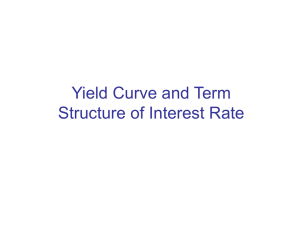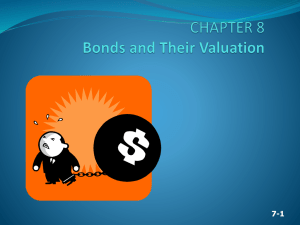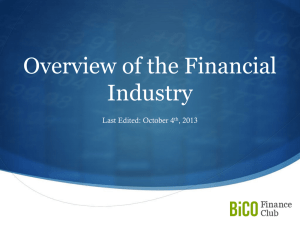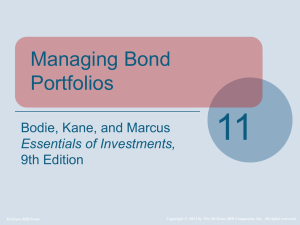Slides - Leeds School of Business
advertisement
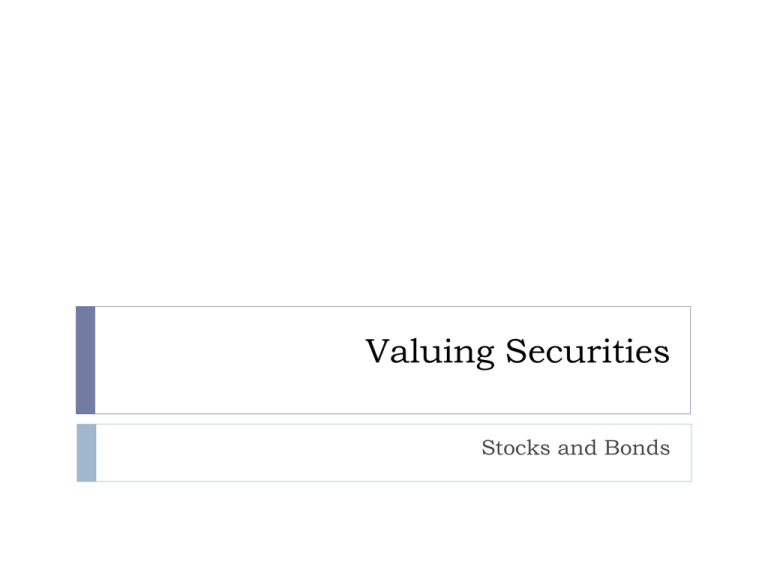
Valuing Securities Stocks and Bonds Bond Cash Flows, Prices, and Yields Bond Terminology Face Value Coupon Rate Notional amount used to compute the interest/coupon payments Determines the amount of each coupon payment, expressed as an annual percentage rate, this only describes the payments is not an interest or discount rate Coupon Payment C PN C oupon R ate Face V alue N um ber of C oupon Paym ents per Y ear Zero-Coupon Bonds Zero-Coupon Bond (Zero) Does not make coupon payments Always (almost always) sells at a discount (a price lower than face value), so they are also called pure discount bonds Treasury Bills are U.S. government zero-coupon bonds with a maturity of up to one year. “Strips” Zero-Coupon Bonds Suppose that a one-year, risk-free, zero-coupon bond with a $100,000 face value has an initial price of $97,323.60. The cash flows would be: 0 1 -$97,323.60 $100,000 The bond pays no “coupon,” so how do you receive any compensation? Zero-Coupon Bonds Yield to Maturity The single discount rate that sets the present value of the remaining promised bond payments equal to the current market price of the bond. For a Zero-Coupon bond: P FV (1 YT M n ) n For a risk free zero coupon bond, this is also the actual annualized return (actual n-year return). Can also see this as the IRR of the bond. Zero-Coupon Bonds Yield to Maturity For the risk free one-year zero coupon bond presented above: 97,323.60 1 YTM 1 100,000 (1 YT M 1 ) 100,000 1.0275 97,323.60 Thus, the YTM is 2.75%. Why must this equal the one year risk free rate? Caution: In bond markets the standard presumption is that a “period” is six months. This calculation does not take this into account, because your textbook does not in the case of zeros. How would we do it the right way? Problem Suppose the following three zero-coupon bonds are trading at the prices shown. Each has a face value of $1,000 and the time to maturity shown in the table. What is the yield to maturity for each bond? Maturity 1 Year 2 Years 3 years Price 980.39 942.60 901.94 Solution The general formula is found by re-arranging the present value equation: P FV (1 YTM n ) n YTM n FV P 1 n 1 The specific solutions in our example are: 1 Year – YTM 2 Years – YTM 3 Years – YTM The yield curve we discussed before is a set of yields to maturity of zero coupon treasury securities. How would it actually be done? Coupon Bonds Yield to Maturity The YTM is the single discount rate that equates the present value of the bond’s remaining cash flows to its current price. Yield to Maturity of a Coupon Bond 1 1 FV P C PN 1 N N y (1 y ) (1 y ) For a coupon bond the YTM is an artificial yield intrinsic to the bond itself. An IRR for the bond based on promised payments. YTM – Example On 9/1/95, PG&E bonds with a maturity date of 3/01/25 and a coupon rate of 7.25% were selling for 92.847% of par, or $928.47 per $1,000 of face value. What is their YTM? Semiannual coupon payment = 0.0725*$1,000/2 = $36.25. Number of semiannual periods to maturity = 30*2 – 1 = 59. YTM - Example 1 1 1000 $ 928 . 47 = $ 36 . 25 59 59 r / 2 ( r / 2 )( 1 r / 2 ) (1 + r / 2 ) r/2 can only be found by trial and error. However, calculators and spread sheets have algorithms to speed up the search. Searching reveals that r/2 = 3.939% or a stated annual rate (YTM) of r = 7.878%. Note: this is, sort of, an effective annual rate of: 2 (1 . 03939 ) 1 8 . 03 % But sort of is not good enough, so never ever do this!! Can we use YTM as a measure of expected return for the coupon bond? Example Suppose that now the yield to maturity for the PG&E bonds has changed to 7% (on a stated annual basis, i.e. APR, with semi-annual compounding). What must be the current price of the bond? Note that the bond itself has not changed (assume for simplicity that the change occurs instantaneously) only its price. Example We find the price using the present value of the bond payments discounted at the YTM. 1 1 1000 P rice = $36.25 59 59 .07 / 2 (.07 / 2)(1 .07 / 2) ( 1 + .07 / 2 ) 1 1 1000 $1031.02 $36.25 59 59 .07 / 2 (.07 / 2)(1 .07 / 2) (1 .07 / 2 ) Does it make sense that the price changed like this? Discounts and Premiums If a coupon bond trades at a discount, an investor will earn a return both from receiving the coupons and from receiving a face value that exceeds the price paid for the bond. If a coupon bond trades at a premium it will earn a return from receiving the coupons but this return will be diminished by receiving a face value less than the price paid for the bond. If a bond trades at a discount, its yield to maturity will exceed its coupon rate. If a bond trades at a premium, its coupon rate will exceed its yield to maturity. Most coupon bonds have a coupon rate set so that the bonds will initially trade as close as possible to par. The Yield Curve and Bond Arbitrage Using the Law of One Price and the yields of default-free zero-coupon bonds, one can determine the arbitrage free price and yield of any other default-free bond. The default-free zero-coupon yield curve provides sufficient information to price all default-free bonds. Replicating a Coupon Bond Replicating a two-year $1,000 bond that pays a 5% coupon using four zero-coupon bonds: time 0 1/2 1 1½ 2 coupon bond - Price $25 $25 $25 $1,025 6 month zero -Price $25 1 year zero -Price 18 month zero -Price 2 year zero -Price portfolio - sum of prices $25 $25 $1,025 $25 $25 $25 $1,025 Replicating a Coupon Bond Yields and Prices (per $100 Face) for Zero Coupon Bonds Maturity 6 months 1 year 1 ½ years 2 years YTM 2.0% 3.00% 3.50% 4.00% Price $99.01 $97.07 $94.93 $92.38 Again these are the spot rates on the yield curve. A useful way to think about these prices is: if I want to buy $100 to be received in one year it costs me $97.07. Replicating a Coupon Bond Zero Face Value Needed Cost/Price 6 month $25 $99.01/4 = $24.75 1 year $25 $97.07/4 = $24.27 18 month $25 $94.93/4 = $23.73 2 year $1,025 ($92.38x41)/4 = $946.90 Total Cost $1,019.65 By the Law of One Price, the two-year coupon bond must trade for a price of $1,019.65. Value a Coupon Bond Using Zero-Coupon Yields The price of a coupon bond must equal the present value of its coupon payments and its face value, each discounted at the relevant spot rate. Price of a Coupon Bond P V (B ond C ash Flow s) PV CPN 1 YT M 1 25 P 1.01 25 1.015 2 CPN (1 YT M 2 ) 25 1.0175 3 2 CPN FV (1 YT M n ) 25 1000 1.02 4 n $1,019.65 Where the YTMn‘s are the yields to maturity of an n-period zero. Coupon Bond Yield to Maturity Knowing the price we can of course also find the yield to maturity of the coupon bond. P $1, 019.65 P 25 1.0198 25 (1 y ) 25 1.0198 2 25 (1 y ) 25 1.0198 3 2 25 (1 y ) 25 1000 1.0198 4 3 25 1000 (1 y ) $1, 019.65 Annualized this is 3.96% (1.98%x2), compare this to the zero-coupon yields. 4 Stock Valuation: An Example 3M is expected to pay a dividend of $1.92 per share in the coming year. You expect the stock price to be $85 per share at the end of the year. Investments with equivalent risk have an expected return of 11% (the cost of equity capital, rE). What is the most you would pay today for 3M stock? What dividend yield and capital gain rate would you expect at this price? Solution The law of one price: the value of a security is determined by the discounted expected cash flow associated with owning it. P0 D iv1 P1 (1 rE ) $1.92 $85 (1 .11) D ividend Y ield D iv1 P0 C apital G ains Y ield P1 P0 P0 $78.31 $1.92 2.45% $78.31 $85.00 $78.31 8.54% $78.31 Total Return = 2.45% + 8.54% = 11% (but for rounding) so at this price the investor is receiving an appropriate return in expectation. A Multi-Year Investor What is the price if we plan on holding a stock for two years? P0 D iv1 1 rE D iv 2 P2 (1 rE ) 2 Again the price must be the present value of the future cash flows or one side (i.e. either the buyer or the seller) will refuse to trade. A Multi-Year Investor What is the price if we plan on holding a stock for N years? P0 1 rE D iv2 (1 rE ) 2 D iv N (1 rE ) PN N (1 rE ) N This is known as the Dividend Discount Model. P0 D iv1 Note that the above equation holds for any horizon. Thus all investors (with the same beliefs) will attach the same value to the stock, independent of their investment horizons. D iv1 1 rE D iv 2 (1 rE ) 2 D iv3 (1 rE ) 3 n 1 D iv n (1 rE ) The price of any stock is equal to the present value of all of the expected future dividends it will pay. n The Dividend-Discount Model Constant Dividend Growth A simple forecast for the firm’s future dividends states that they will grow at a constant rate, g, forever. P0 D iv1 rE g , rE D iv1 g P0 The value of the firm depends on the current dividend level, the cost of equity, and the growth rate. The expected return is from dividend yield and the expected capital gain (g by assumption). Problem Problem AT&T plans to pay $1.44 per share in dividends in the coming year (assume dividends are paid at year end for simplicity). Its equity cost of capital is 8%. Dividends are expected to grow by 4% per year in the future. Estimate the value of AT&T’s stock. Changing Growth Rates We cannot use the constant dividend growth model to value a stock if the growth rate is not constant (huh). For example, young firms often have very high initial earnings growth rates. During this period of high growth, these firms often retain 100% of their earnings to exploit profitable investment opportunities. As they mature, their growth slows. At some point, their earnings exceed their investment needs and they begin to pay dividends. Changing Growth Rates PN D iv N 1 rE g Dividend-Discount Model with Constant Long-Term Growth P0 D iv1 1 rE D iv 2 (1 rE ) 2 D iv N (1 rE ) N 1 (1 rE ) N D iv N 1 r g E Example Batesco Inc. just paid a dividend of $1. The dividends of Batesco are expected to grow by 50% next year (time 1) and 25% the year after that (year 2). Subsequently, Batesco’s dividends are expected to grow at 6% in perpetuity. The proper discount rate for Batesco is 13%. What is the fair price for a share of Batesco stock? Example cont… First, determine the dividends. Draw the timeline! D0 = $1 g1 = 50% D1 = $1(1.50) = $1.50 g2 = 25% D2 = $1.50(1.25) = $1.875 g3 = 6% D3 = $1.875(1.06) = $1.9875 0 g =50% 1 1 1.50 g2=25% 2 g =6% 3 1.875 3 1.9875 g4=6% 4 ...... 2.107 Example cont… Supernormal growth period: Ps= D1 (1 + r E ) 1.50 (1.13) + 1.875 (1.13 ) 2 = $ 2.796 D 3 = 1.9875 = $28.393 r E - g 3 0.13 - 0.06 Discount Pc to time 0 and add to Ps: P0= Ps+ (1 + r E ) = 2 Constant growth period. Value at time 2: Pc = D2 + Pc (1 + r E ) 2 = 2.796 + 28.393 (1.13 ) 2 = $2 5 . 03 What if supernormal growth lasted 8 yrs at 50%? Limitations of the Dividend-Discount Model There is a tremendous amount of uncertainty associated with forecasting a firm’s dividend growth rate and its future dividends (particularly those many periods from now). Compounding the issue, dividends are discretionary. Small changes in the assumed dividend growth rate can lead to large changes in the estimated stock price. Many firms pay no dividends (especially true recently). Discounted Free Cash Flow Model The Discounted Free Cash Flow Model Determines the value of the firm to all investors, including both equity and debt holders – first a definition E nterprise V alue E quity V alue D ebt V alue E xcess C ash The enterprise value of a firm can be interpreted as the net cost of acquiring control of the firm, buying its equity, taking its excess cash (really the value of all non-operating assets), paying off all debt, and owning the then unlevered business or “enterprise”. Discounted Free Cash Flow Model Valuing the Enterprise U nlevered N et Incom e Free C ash Flow E B IT (1 c ) D epreciatio n C apital E xpenditures Increases in N et W orking C apital Recall: Free Cash Flow is Cash flow available to pay both debt holders and equity holders Discounted Free Cash Flow Model V 0 P V (A ll Future Free C ash Flow of Firm ) E quity V alue F irm V alue P0 V 0 E xcess C ash 0 D ebt 0 S hares O utstanding 0 Discounted Free Cash Flow Model Implementing the Model Since we are discounting cash flows to both equity holders and debt holders, the free cash flows should be discounted at the firm’s weighted average cost of capital, rwacc. If the firm has no debt, rwacc = rE. The weighted average cost of capital is a discount rate we will discuss at length soon. For now just know that it is a rate appropriate for discounting FCF. Discounted Free Cash Flow Model Implementing the Model V0 F C F1 1 rw acc F C F2 (1 rw acc ) 2 F C FN (1 rw acc ) N VN (1 rw acc ) Often, the terminal value is estimated by assuming a constant long-run growth rate gFCF for free cash flows beyond year N, so that: VN F C FN 1 rw acc g F C F (1 g F C F ) F C F N ( rw acc g F C F ) N Example: Stock Price from FCF A proforma forecast of the (simplified) income statement for Clive.com appears below. As Clive.com is a mature firm it is forecast that future capital expenditures will be for the replacement of worn equipment (simplifying but wrong - later). The firm’s experience is that necessary levels of net working capital are 12% of sales in any year. The firm has $75 Million in excess cash on hand, $50 Million in outstanding debt, 100 Million shares of stock outstanding, and faces a 35% tax rate. After 2014 it is expected that free cash flows for the firm will increase at a constant rate of 3% and due to its risk and use of debt a WACC of 15% is appropriate. What is the value of Clive.com’s equity and its share price at the start of 2010? Proforma Income Statement for Clive.com ($ in Millions) 2009 2010 2011 2012 2013 2014 sales 672.3 739.53 813.483 878.5616 931.2753 977.8391 cogs 235.305 258.8355 284.7191 307.4966 325.9464 342.2437 op exp 268.92 295.812 325.3932 351.4247 372.5101 391.1356 interest 3.5 3.5 3.5 3.5 3.5 3.5 taxes 57.60125 63.48388 69.95476 75.64914 80.26159 84.33592 Net Income 106.9738 117.8986 129.916 140.4913 149.0572 156.6239 Solution First we need a forecast of future free cash flow. EBIT Unlevered NI NWC DNWC Plus Depr Less Cap Ex FCF 2010 2011 2012 2013 2014 184.8825 203.3708 219.6404 232.8188 244.4598 120.1736 132.191 142.7663 151.3322 158.8989 80.676 88.7436 97.61796 105.4274 111.753 117.3407 8.0676 8.87436 7.809437 6.325644 5.587652 ----------112.106 123.3166 134.9568 145.0066 153.3112 What about the rest? For simplicity assume FCF in 2015 is forecast to be $153.31x1.03 = $157.91 – more on this later Terminal value is then $157.91/(0.15 - .03) = $1,315.92 (end of 2014). PV of TV is $1,315.92/(1.15)5 = $654.25 Solution The present value of the free cash flow for the forecast period is: PV $112.11 1.15 $123.32 1.15 2 $134.96 1.15 3 $145.01 1.15 4 $153.31 1.15 5 $438.60 Now just add the present values: PV(forecast period) + PV(Terminal Value) V 0 $438.60 $654.25 $1, 092.84 Enterprise value plus Excess Cash less existing Debt = Equity value E quity V alue $1, 092.84 $75 $50 $1,117, 84 Share price is Equity value divided by the number of shares S hare P rice $1,117.84 / 100 $11.18 Challenge Question Consider Example 9.7 in your textbook – Kenneth Cole Suppose that due to changing cost structures and increasing competition in the industry: They expect EBIT to be 8.5% of sales rather than 9%. The increase in necessary NWC is expected to be 10.25% of the increase in sales. Finally you expect a more modest 2% long-term growth rate rather than the 4% shown (keep all other sales growth rates as shown). Under these conditions what is your estimate of the value of a share of KCP’s stock?




